Tom's Guide Verdict
Designed to display series, movies, and artwork with equal fidelity, Samsung’s The Frame is a TV built for both art fans and AV enthusiasts. Unfortunately, it might not quite satisfy either group.
Pros
- +
Generally good picture quality
- +
Solar-powered remote
- +
Plentiful sizes, customization options
- +
Includes Samsung Slim-Fit Wall Mount
Cons
- -
Poor viewing angles
- -
Artworks or subscriptions may be expensive, unnecessary
- -
Outdated, clunky smart interface
- -
No Dolby Vision support
Why you can trust Tom's Guide
Price: $1,999.99
Screen size: 65 inches
Model: QN65LS03BAF
Resolution: 3,840 x 2,160
HDR: HDR10, HDR10+, HLG
Refresh Rate: 120 Hz
Ports: 4 HDMI, 2 USB
Audio: 40W
Smart TV Software: Tizen
Size (without stand): 32.8 x 57.4 x 1 inches (HWD)
Weight (without stand): 49.4 lbs
The Samsung 65-inch Class The Frame QLED 4K Smart TV (2022), hereafter known as The Frame, is the latest version of one of the industry’s more daring experiments: a set positioned somewhere between a traditional TV and an art installation.
Catering to those who want to admire and ponder humanity’s greatest paintings and photographs while devouring digital entertainment in 4K resolution, it’s designed to appeal to every style and transform any wall into a Louvre-worthy gallery.
How well it works, like the artwork it tries to dutifully present on its glossy screen, may be in the eye of the beholder. In my personal view, it tries so hard to do multiple things that it doesn’t get any of them exactly right. As a TV, the matte screen and uneven picture quality make most video look just a tiny bit off; the images in Art mode, on the other hand, look exquisite, but they veer toward the expensive, and introduce unique usability concerns. Whether it’s right for you depends on a lot of factors; ultimately, you don’t need to know a lot about art, but you need to know what you like.
Samsung The Frame QLED 4K Smart TV (2022) review: Pricing and availability
Undoubtedly operating under the assumption that a TV-as-painting ought to be available in about as many sizes as paintings, Samsung offers a whopping seven different versions of The Frame.
- Samsung 32" Class The Frame QLED HDR Smart TV (QN32LS03BBF): $599.99
- Samsung 43" Class The Frame QLED 4K Smart TV (QN43LS03BAF): $999.99
- Samsung 50" Class The Frame QLED 4K Smart TV (QN50LS03BAF): $1,299.99
- Samsung 55" Class The Frame QLED 4K Smart TV (QN55LS03BAF): $1,499.99
- Samsung 65" Class The Frame QLED 4K Smart TV (QN65LS03BAF): $1,999.99
- Samsung 75" Class The Frame QLED 4K Smart TV (QN75LS03BAF): $2,999.99
- Samsung 85" Class The Frame QLED 4K Smart TV (QN85LS03BAF): $4,299.99
Because the 55- through 85-inch models are functionally the same hardware-wise, we would expect them to perform similarly to the 65-inch model we evaluated. The smaller sets have slightly fewer features (such as skimpier speakers and no 4K/120Hz support), and the 32-inch set maxes out at 1,920x1,080 (1080p, or full HD) resolution, but the operating system, interface, and general art experience should be the same on all sizes.
Samsung The Frame QLED 4K Smart TV (2022) review: Design
Samsung’s quest to make the The Frame look and behave like a painting is thoroughly reflected in its design. Whereas most companies these days minimize their sets’ bezels, Samsung has gone the other direction by making them nearly a half-inch on all sides—just like a picture frame. The bezel on our review unit was the default black, but you can choose from several other colors and styles (whether straight or beveled) to better match your personal aesthetic and pre-existing art collection, and you may change them out at any time. Each of these will add an extra $199.99 to the price, however.
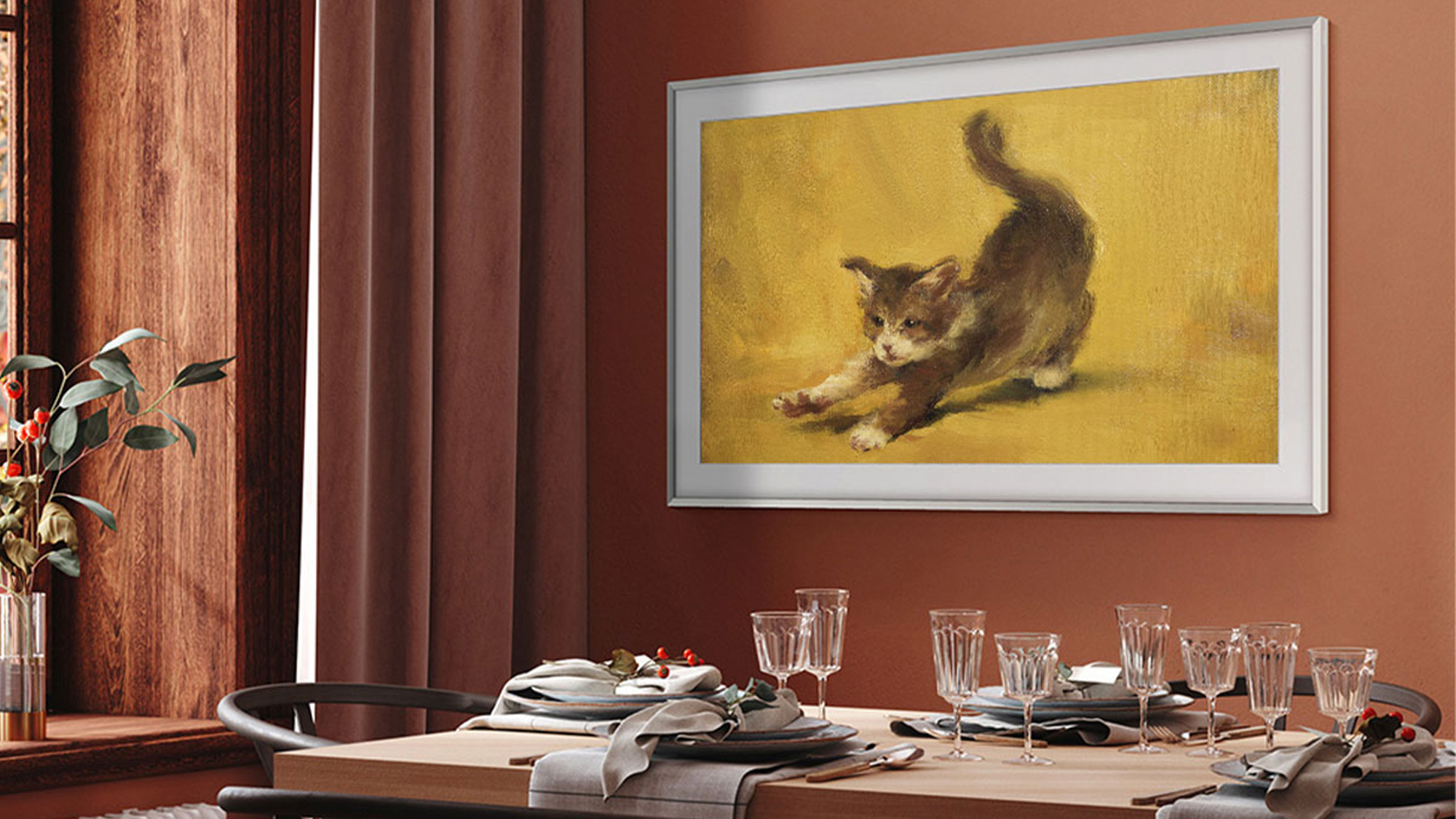
Otherwise, The Frame measures 32.8x57.4x1 inches (HWD) and weighs 49.4 pounds—about standard TV-size, but roughly 45% slimmer than previous versions.
Get instant access to breaking news, the hottest reviews, great deals and helpful tips.
It maintains its sleek, uncluttered look through the presence of almost no ports on the set itself. In fact, the primary features on the rear panel are the holes for attaching a 400x300mm VESA mount or the included Samsung Slim-Fit Wall Mount, which allows the set to rest almost perfectly flush against the wall.
Other options include an adjustable two-piece stand for placing the set on an entertainment center, with room for a soundbar underneath; and the standalone, three-legged Studio Stand ($299.99), which flaunts its gallery mindset. MyShelf products let you add top and bottom shelves and peg boards to frame the TV, at various prices ranging from $99.99 to $299.97.
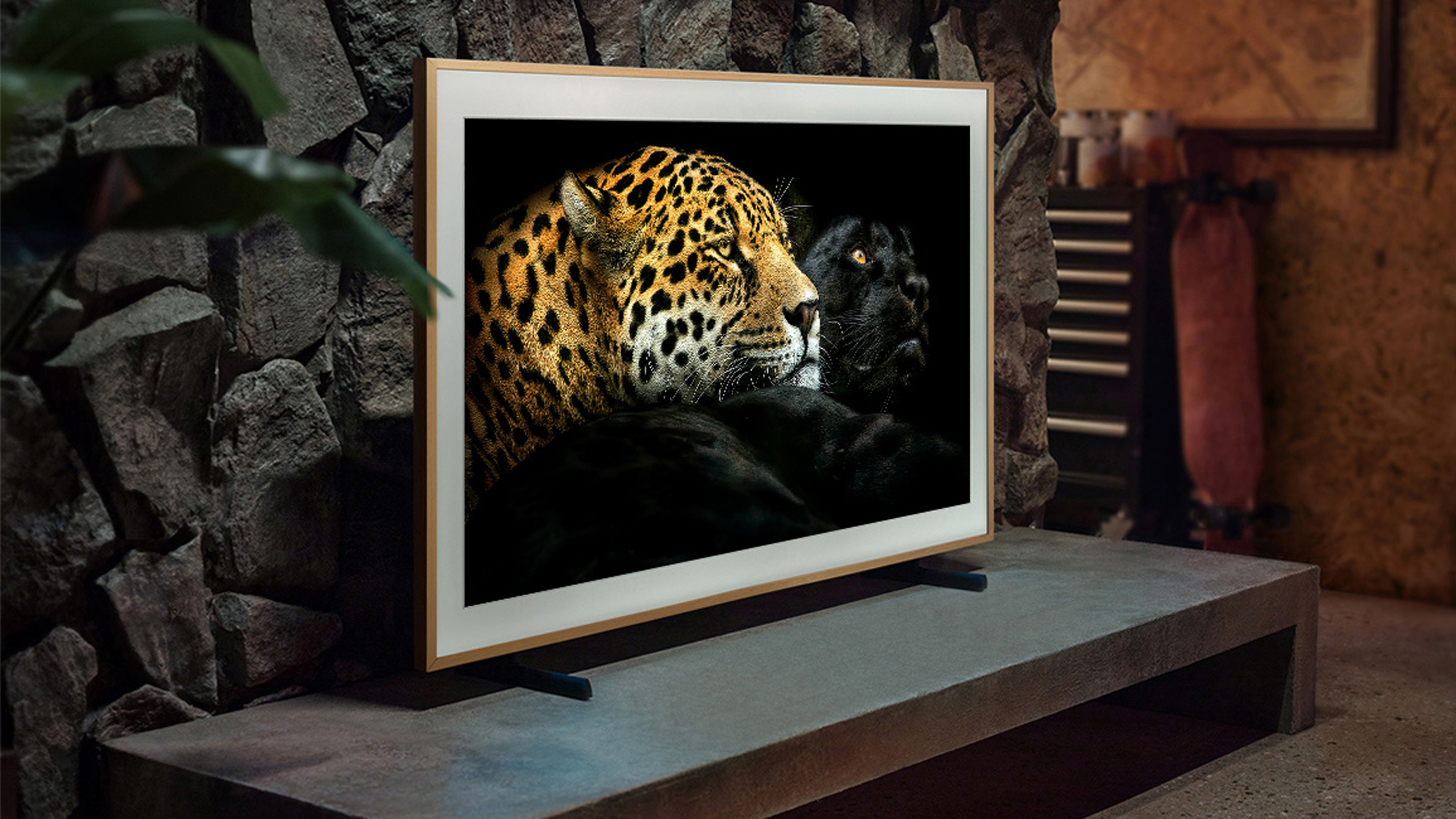
The only port on the rear panel is the One Connect jack, which lets you run a single, thin cable through a channel cut the panel to the included One Connect Box located elsewhere in the room; the bundled cable is 16 feet long, so you can put it anywhere convenient. (A 49-foot cable is also available.)
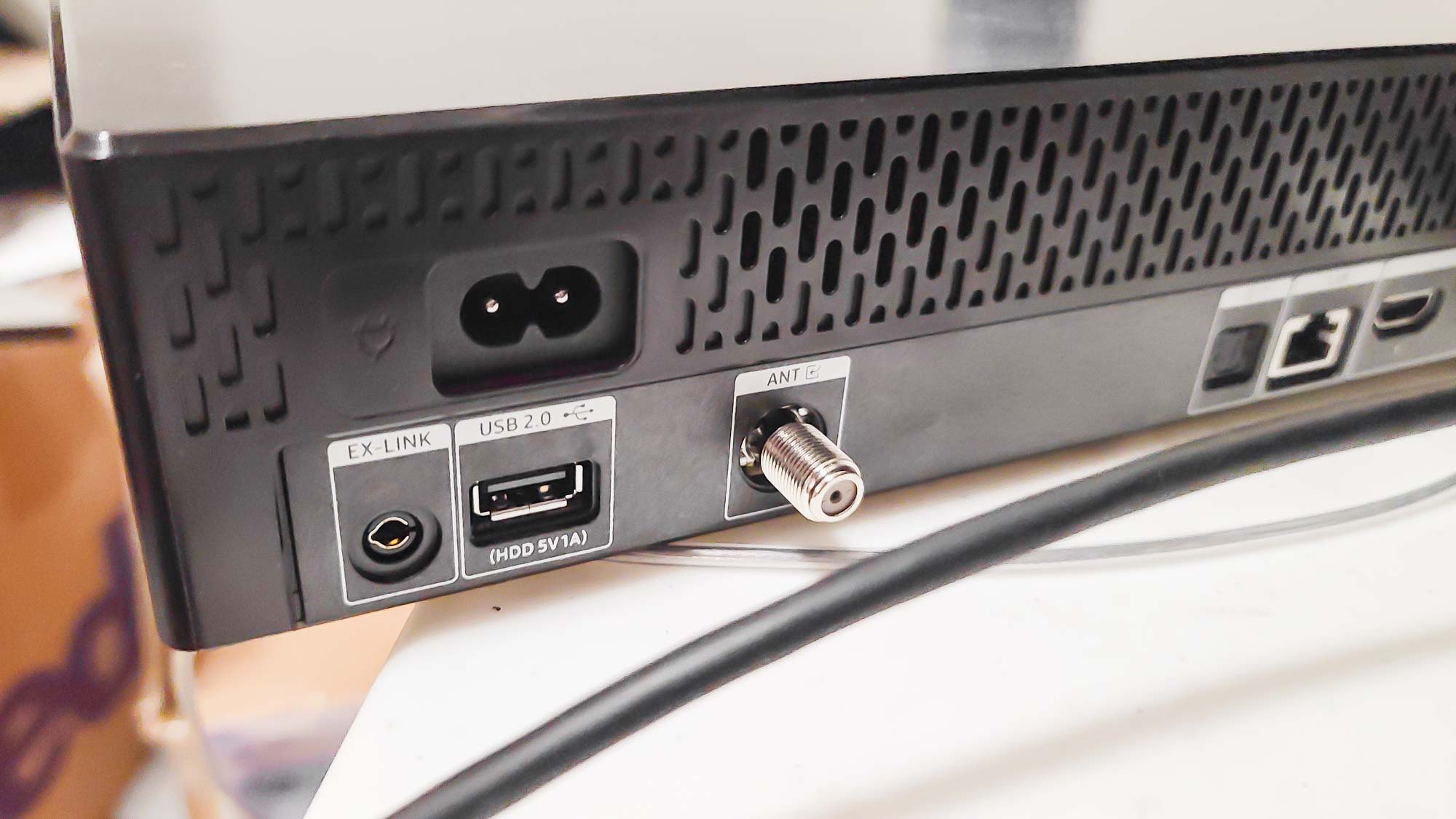
The Box is itself on the bulky side, measuring 2.6x13.7x5.4 inches, so you’ll need to find a place to put it that makes sense given how often you plan to access the many ports on it.
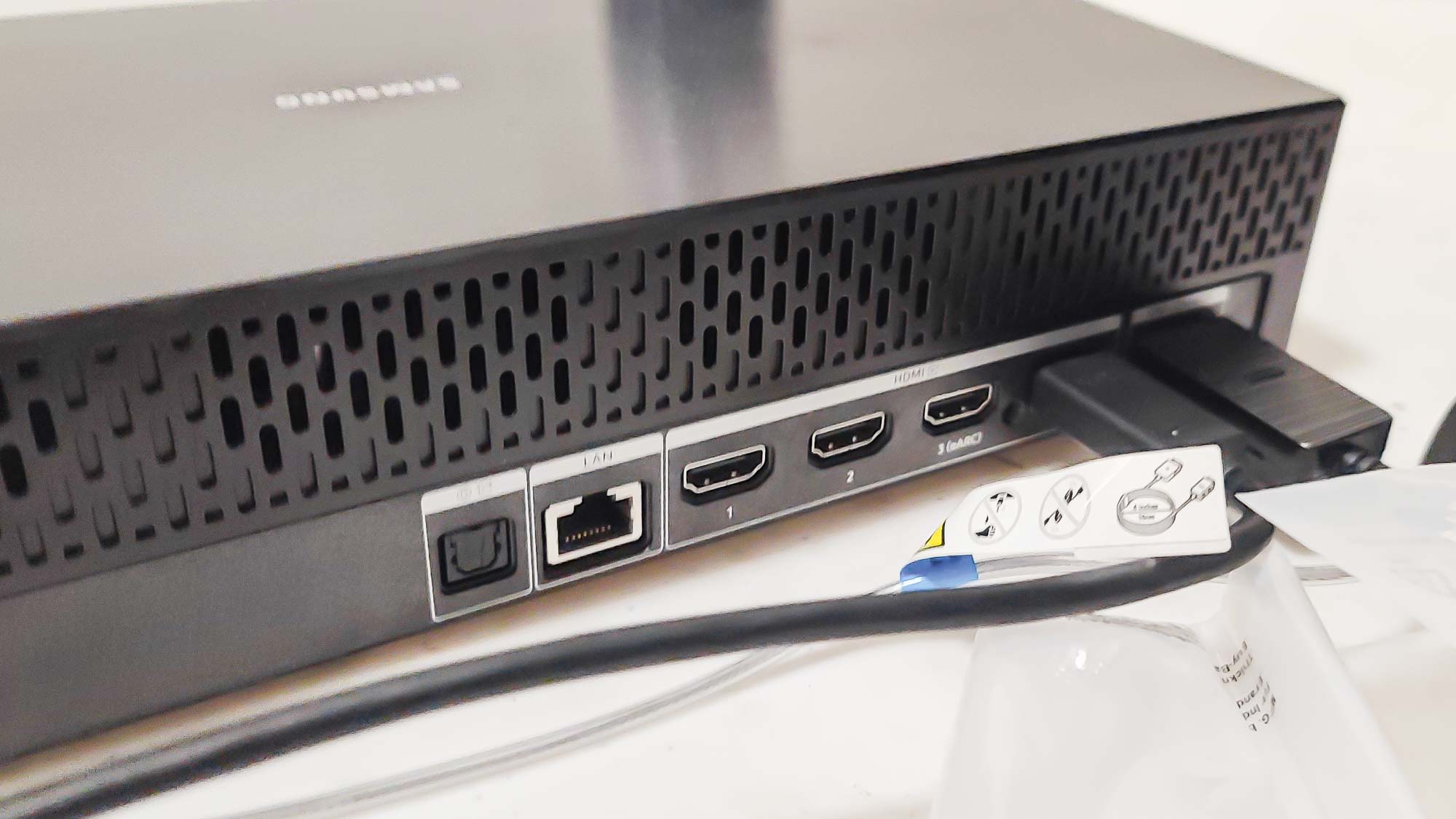
These include the power connector, an Ex-Link service port, a USB 2.0 charging port, the coaxial cable connector, the digital audio out port, four HDMI ports (one designated for eARC and one for 4K 120Hz gaming on this model, though the boxes for the 32-, 43-, and 50-inch sets have four 60Hz ports instead), and the One Connect input port. A second USB 2.0 charging port is on the box’s right side.
Samsung The Frame QLED 4K Smart TV (2022) review: Performance
How well does The Frame unite the (relatively) newfangled technology of television with the old-fashioned, time-tested precepts of visual art? To find out, we subjected it to our display testing regimen, using a SpectraCal VideoForge Pro pattern generator, an X-Rite i1 Pro spectrophotometer, and Portrait Displays’ Calman calibration software.
With a Delta-E (which rates the difference between the color at the source and the color as displayed, with lower numbers being better) of 2.9961, and covering 99.7548% of the Rec.709 color gamut, the The Frame displays accurate and rich colors in its near-calibration-quality Filmmaker Mode. Its brightness was more limited (at 317.8 nits), but switching to another mode will usually result in a brighter picture.
The same is true of viewing HDR content, as there Filmmaker Mode’s maximum brightness jumped up to 500 nits, which isn’t super bright for HDR (the Samsung S959B QD-OLED recently hit 1,050 nits and last year’s Sony A80J OLED got to 600) but is more than acceptable in most situations. As far as HDR color, The Frame covered 92.1% of the UHDA-P3 color gamut—not terrible, but not as good as you’ll see on other sets. There’s no support for Dolby Vision, but there is for HDR10, HDR10+, and HLG.
Most video on The Frame played decently under typical, in-front-of-the-set viewing conditions. The vibrant, Colombian kaleidoscope of Disney’s Encanto swirled to colorful life in the daytime and nighttime scenes alike, and the piercing color palettes of Spider-Man: No Way Home came through beautifully in both the action-packed and lower-key scenes.
Suffering somewhat more was The Batman, which looked a bit cloudier in the darker scenes due to The Frame’s lack of a local dimming array to punch up the contrast in certain areas. This was more noticeable still in Denis Villeneuve’s Dune, where the Atreides family’s skin tones tended to blend in with the oppressively beige sands of Arrakis. (The Standard picture mode was the best at mitigating this effect for the movie.)
Wandering too far from the center of the screen will apply that look to any content; the poor viewing angles of the The Frame ensure that even before you hit the corners of the set, the picture will look grey and blighted, with distorted colors. (A full-purple test screen looked practically rose from the extreme edges.) The set does upscale well, though, with Mission: Impossible—Fallout losing only a trace of its razor-sharp detail between the 1080p and native 4K versions we watched.
Samsung The Frame QLED 4K Smart TV (2022) review: Art functionality
The big selling point of The Frame is its art integration, which is accessible via a menu option from the home screen. You can scroll through the default options, which are organized into categories such as Featured, Global Top 20, Etsy, and more.
You can page through pieces from different schools, in different media, and by different artists, and there are a number of curated collections to choose from. In addition, you can browse the most popular works (either in your region, or by such qualities as theme or type), and changing groupings help you find timely pieces you may not have thought of; some of my warmer-month options included “First day of summer” and “The call of the sea.”
You can configure the TV to display a mat around the art, to increase the realism factor, or stop displaying art and power down after a certain point if it senses no light or motion (for the latter, you can adjust the set’s motion detection sensitivity).

There are different ways of acquiring art for display: you can buy individual pieces if you want, or you can subscribe for unlimited access to all of Samsung’s more than 1,400 offerings for $4.99 per month or $49.90 per year; PayPal, Samsung Pay, or credit or debit card accounts are all accepted forms of payment. Of course, you can supply your own photos or digital works by connecting to the TV via USB or through the SmartThings app and moving files. Or you can choose from one of the pieces classified as Complimentary.
A few of these works are famous enough for non-aficionados to recognize, such as Ballet Rehearsal on Stage (Degas), or Monet’s Garden at Sainte-Adress or especially Water Lilies. But the other seven in the Classic sub-collection are less well known, despite being attached to Big Names (Gauguin, Klimt, Munch). And the other sub-collections range from unfamiliar and uninspiring photographs to patterns and renderings that look more like Pointillistic interpretations of Windows wallpaper to curious, animated cinemagraphs and things resembling YouTube drone videos.
Outside of the classics, I found very little to like here. You’re required to either invest significant time or money to take advantage of the TV’s big distinguishing feature, and I can’t blame anyone for not wanting to do that. The reflection-reducing matte screen and mat option make the most of whatever you display; personal preferences aside, I never found anything that didn’t look good. But a $4.99 subscription—or a $19.99 “purchase” price—to enjoy Van Gogh’s Starry Night strikes me as overkill in an era when many museums (to say nothing of Google images) make it a snap to acquire high-quality digital reproductions of the world’s masterpieces.

Yes, the possibility exists that you can use The Frame to supplement your décor and broaden your horizons. But not everyone is going to love this style of art as a service.
Samsung 65-inch Class The Frame QLED 4K Smart TV (2022) review: Audio
The 40-watt audio system in The Frame produces satisfactory sound for any kind of content. It never gets too loud, but there’s also no detectable clipping even at the top of the volume range. The car chases in The Batman, Lin-Manuel Miranda’s charming songs for Encanto, and straight dialogue in movies and TV shows all sounded clear if somewhat less than full-bodied.
As with most TVs, bass is where The Frame stumbles most; there was little depth to the heavy, throbbing foundation of The Knife’s “Silent Shout,” despite the notes being distinct. More intense treble came across better, such as in soaring soprano vocals that pulsed with power without getting staticky, but the audio handily avoided being either disturbingly bad or arrestingly good. (You may want to pick up one of Tom’s Guide’s best soundbars to enhance the viewing experience.)
Samsung The Frame QLED 4K Smart TV (2022) review: Gaming
Whether video games are art has been debated for years (and won’t be solved anytime soon), but The Frame integrates them smoothly. The set’s input lag time of 9.5ms (as measured with a Leo Bodnar 4K Signal Lag Tester) is just the tiniest tick above what we saw with the S95B OLED (9.2ms), but it’s significantly below our 20ms threshold for a smooth gaming experience.
Aside from Dolby Vision, every major gaming technology is supported, including Variable Refresh Rate (VRR), and Samsung’s Game Bar provides a ton of information and allows for easily tweaking other key gaming settings. Assassin’s Creed Valhalla played smoothly, though the combination of the matte screen and the lack of local dimming muted the “pop” of the visuals in more dramatic moments, such as when viewing a crimson sunset over a silvery, winter landscape.
Samsung The Frame QLED 4K Smart TV (2022) review: Smart features
As with Samsung’s OLED, The Frame uses Samsung’s aging Tizen operating system for its primary interface. It has all the same problems here: its tendency to serve up content you’re unlikely to be interested in (including everything I ever flipped through on the free Samsung TV Plus channel); the overly clumsy menu design that buries many basic, everyday options and makes performing simple tasks (such as changing an HDMI input) take far longer than they should. The unsettling sparse-busy nature also makes it pale in comparison to the better options out there, such as Google TV.

At least there’s plenty of support for voice assistants, including Amazon Alexa, Google Assistant, and Samsung Bixby, so using those is probably the better way to go. There is also streaming support for Apple AirPlay 2.
Samsung The Frame QLED 4K Smart TV (2022) review: Remote
One of Samsung’s most adventurous 2022 TV innovations is the SolarCell Remote, which comes with the The Frame. Instead of swapping out the batteries when the remote runs out of juice, you just turn it over to reveal a solar panel and place it in the morning sun (other times of day will work) until it’s charged. It’s a winning combination of convenience and environmental responsibility. But it doesn’t make up for everything else you don’t get.
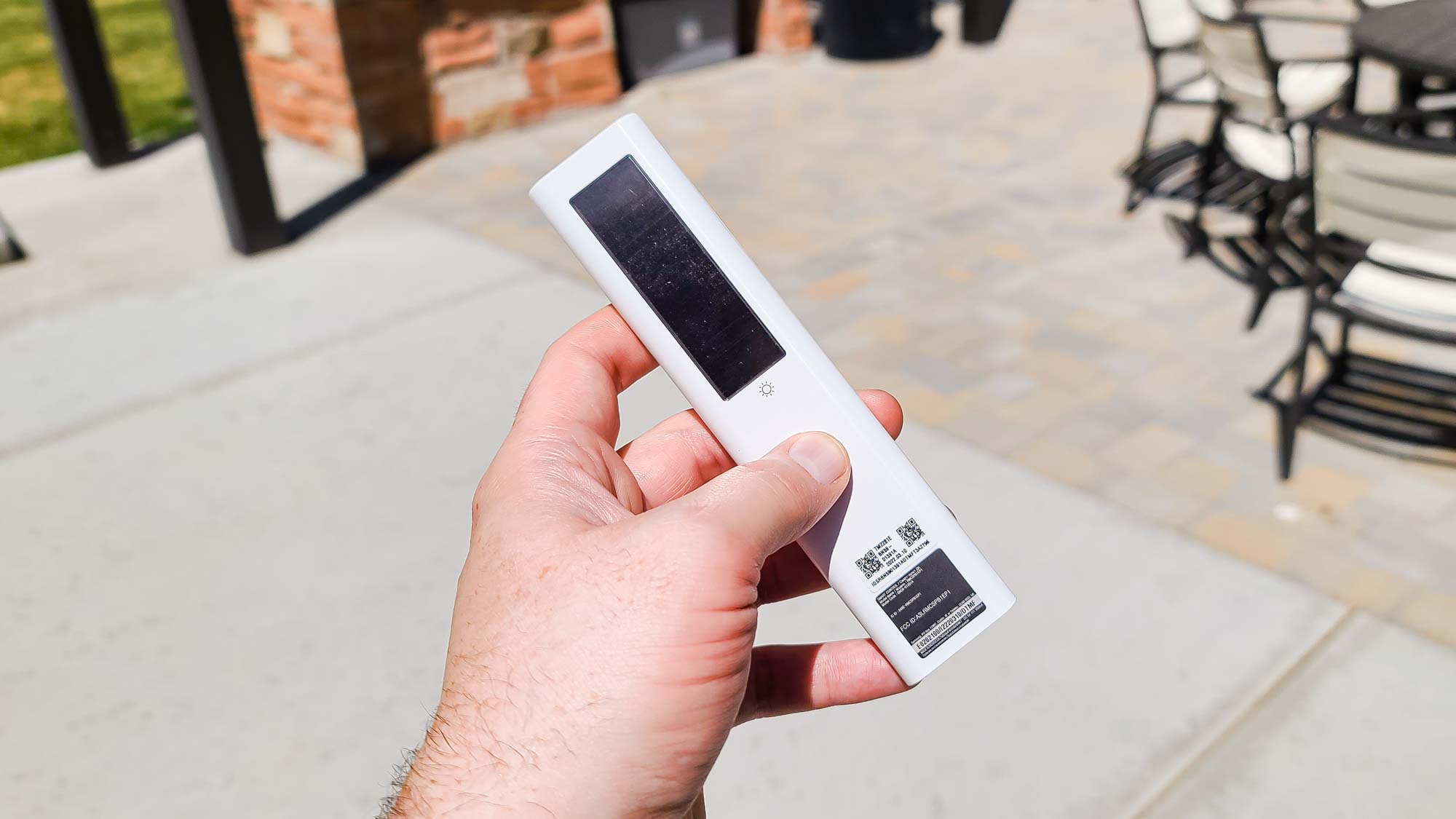
The controls might be even more Minimalist than Mondrian, with the main controls being buttons for Power (which we’ll come back to), Back, Home, and Play/Pause; Volume and Channel Rockers; and a directional pad with a Select button. Four dedicated keys (for Samsung TV Plus, Netflix, Amazon Prime Video, and Disney+) are at the bottom, and buttons for Settings/Numbers/Colors, voice control activation, and Multi view are at the top.
Remote navigation takes a while, particularly if you want to change settings; bizarrely, there’s no Input button; and you’ll have to read the documentation to make the most of the “hidden” secondary functions. (Is a dedicated Mute button really too much to ask for?) If anything, Samsung’s surge toward simplicity has made interaction with Tizen more complicated and less intuitive.

Speaking of which, pressing the Power button doesn’t turn the TV off—it just brings up the art. I suppose the logic is that that’s why you bought the set in the first place, and why would you want a black screen unless you’re studying Kazimir Malevich? But this, too, runs counter to convention, as the Power button usually, you know, turns off the power. Samsung didn’t even relabel the button. If you actually want to turn the set off, you have to hold down the button for a few seconds. To me, it’s weird to have to relearn how to use a Power button.
The only major difference between The Frame’s remote and the Samsung OLED’s? The color. This remote, in yet another break from tradition, has an all-white casing. I have to give Samsung credit for this mod rethinking that fits in with the Mod convention-flaunting. But that I’d rather look at the remote than use it says something—and probably not what Samsung intended.
Samsung The Frame QLED 4K Smart TV (2022) review: Verdict
For the Pulitzer Prize–winning musical he wrote with James Lapine about the work and legacy of French post-Impressionist Georges Seurat, Sunday in the Park With George, Stephen Sondheim penned the now-classic lyric, “Art isn’t easy / Any way you look at it.” And that’s rarely been more true about a technology product than it is about Samsung’s The Frame. Fusing the TV know-how of the consumer electronics giant with the comfortably conflicting attitudes of art lovers and dealers, this is a set that makes more sense in its conception than execution, leaving it feeling more like a question mark than the average Jackson Pollock.
The picture is hardly bad, but you can find TVs that can do better and cost about as much money or less. Digital photo frames are smaller and won’t have the lux matte screen, but they’re easier and less expensive to use. And you can see a sprawling spectrum of art (provided you’re willing to pay for it), but it lacks the intoxicating mystique of truly original, hand-crafted works.
The Frame gives you a taste of all these worlds without giving you the best of any of them, and its myriad customization and design choices won’t be sufficient compensation for any but the most dedicated aesthetes. If you’re part of the narrow slice of the market that wants to own a TV and pretend it’s something else, great—you’ll probably be thrilled with the art-centric features, and if it’s not quite the best TV you can buy, does it matter? It’s all in how you frame it, but unless you're married to the idea of your TV blending in with a wall of artwork, we recommend that you look elsewhere when buying a new 4K TV.
Matthew Murray is the head of testing for Future, coordinating and conducting product testing at Tom’s Guide and other Future publications. He has previously covered technology and performance arts for multiple publications, edited numerous books, and worked as a theatre critic for more than 16 years.


